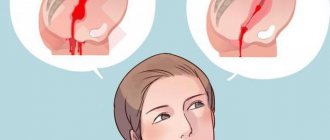Very often, after childbirth, a woman faces the problem of pain in the lower abdomen.
There may be several reasons for this phenomenon. Some of them are physiological in nature, some are associated with certain pathological conditions. Let's look at them in more detail and try to understand why the stomach hurts after childbirth, how it hurts and how long these pains can last.
Causes of abdominal pain after childbirth
Pain in the lower abdomen of a cramping nature is associated with the fact that after childbirth the uterus still continues to contract, and this is a completely natural process. Doctors perceive complaints about this kind of pain positively. This is explained by the fact that after the birth process, a large amount of oxytocin, the hormone responsible for uterine contractions, is released into the blood. This hormone regulates labor pains.
These pains continue until the uterus returns to its previous state. After all, from the size of a large ball it should decrease to the size of a fist.
These pains can become more severe when a woman begins to breastfeed her baby, since during this physiological process there is also increased production of oxytocin, which leads to increased uterine contractions.
Typically, such pain in the lower abdomen persists after childbirth for 4-7 days. To reduce pain, you can do special exercises. If after childbirth your stomach hurts very much, you should definitely consult with your doctor about prescribing painkillers.
The lower abdomen hurts after childbirth even after surgery. This is also a variant of the norm. After all, after any surgical intervention, pain remains at the incision site for some time. In such a situation, a woman needs to monitor the condition of the seam and maintain hygiene. After a certain time, the pain will stop.
The lower abdomen also pulls after curettage, which is done if after childbirth a woman has traces of placenta. After this, the woman feels pain in the lower abdomen for quite a long time.
If a woman had ruptures during childbirth, the stitches may hurt. Moreover, pain from the perineum can move to the lower abdomen. In such a situation there is also no reason to worry, since such pain goes away as the sutures heal.
Another reason for abdominal pain of a physiological nature is that after childbirth you have to re-establish the process of urination. At first this is accompanied by a raw pain and burning sensation, but then everything returns to normal and the pain goes away.
All of the above-described causes of abdominal pain after childbirth are natural, and there is no point in worrying about them.
Pathological abdominal pain after childbirth
But it also happens that abdominal pain can be caused by certain pathological changes in the body, which are worth paying special attention to.
Such changes include inflammation of the endometrium, the layer lining the uterus. It can occur after birth by cesarean section, when pathogens enter the uterus. With endometritis, abdominal pain is accompanied by fever, bloody or purulent discharge.
Sometimes the cause of pain can be an exacerbation of gastrointestinal diseases. In this case, you need to try to adjust your diet. You should eat little, but quite often, and drink more fluids.
Very often after childbirth a woman loses her appetite. Eating as needed and resulting in constipation can also cause abdominal pain. Therefore, the nutrition of a woman who has given birth to a child should be complete, regular and balanced.
If symptoms of pathological conditions occur, it is very important to consult a doctor in a timely manner to prevent complications of the disease.
Just as during childbirth with contractions, the uterus contracts and the cervix opens, so after childbirth, young mothers experience contractions, during which the uterus contracts to return to its previous size. Midwife Marite Inzule talks about postpartum contractions and what a woman should do to relieve pain.
The woman feels pain because... the muscles of the uterus contract. They can be felt especially strongly when the baby is suckling, because... at that moment, special hormones are released that help the uterus contract more efficiently. After the first birth, contractions occur more evenly, so contractions are not as noticeable. But subsequent births can cause more noticeable pain, because... The uterus is stretched and needs to contract and contract to its previous size. The intensity of postpartum contractions gradually decreases - on the third day they weaken.
- During breastfeeding, when contractions are most intense, try to relax while exhaling.
- Drink No-shpa, drink it before breastfeeding, so that there will be less pain during breastfeeding.
- Use pain-relieving suppositories
- Use folk remedies. For example, before breastfeeding, drink tea from the cuff - it promotes uterine contraction and cleansing, acts gently, reducing postpartum contractions.
The uterus not only contracts, but also cleanses
During contractions, the uterus not only contracts, but also cleanses itself. Immediately after childbirth there is bloody discharge, after which postpartum discharge or lochia appears. Lochia is bloody in the first days, which is why it is pink. After three to four days they become paler. Around the tenth day they become white or yellowish in color. The discharge continues for 4-8 weeks. If delays occur during cleansing of the uterus, this is indicated by bright contractions, because... the uterus contracts more.
What to do to avoid delays in cleansing the uterus?
- Move regularly.
Perform permitted exercises, especially to strengthen the pelvic floor. Every hour, do at least a couple of breathing exercises - inhale slowly and deeply, and while exhaling, simultaneously pull in the abdominal and pelvic muscles. - Perform a light massage of the uterus and abdomen.
After childbirth, the uterus is located above the pelvis, gradually returning to the small pelvis, so when massaging the abdomen, you also massage the uterus. The abdomen can only be massaged clockwise. - Lie on your stomach.
You can put a pillow under your stomach. - Empty your bladder regularly.
In order for the uterus to cleanse itself, it is important that the woman moves, so after childbirth, as soon as possible, it is recommended to walk, go to the toilet, and move around. Thus, the body is restored, all functions begin to work as usual.
Although all women experience contraction of the uterus after childbirth, not everyone experiences pain. Doctors monitor how the uterus cleanses and contracts in the hospital by feeling the abdomen and thus determining the size of the uterus and its location. After childbirth, the uterus is at the height of the navel, every day it moves 1 cm or the width of a finger until it disappears behind the symphysis on about the 12th day. And you can no longer feel it from the outside.
If necessary, ultrasonography is performed. A high temperature (if it is not from breastfeeding) indicates that some problems or inflammation are appearing. If a woman has a fever, she definitely needs to tell the doctor - the sooner the better, so that the inflammation does not flare up and it can be cured faster.
The baby was born and the mother is sure that the pain and stress are in the past, but this is far from the case. The body is recovering, and contractions after childbirth are not uncommon. Unpleasant pain after childbirth, like contractions, haunts the woman in labor throughout the recovery period. At this time, the mother needs to take care of the child, feed him, communicate with him, and when the stomach hurts after childbirth, as during contractions, this is not easy to do. To recover quickly, you need to know the causes, symptoms and ways to get rid of a frequently occurring problem.
Contractions after childbirth - a disease or a natural process?
A woman's uterus plays a major role in the process of bearing a child. Being the size of a fist in its normal state, during pregnancy it stretches, acquiring significant dimensions. During pregnancy, the baby develops in the uterus, amniotic fluid and the placenta are located. The birth ends, the mother is free of the burden, but the organ remains stretched.
After the end of pregnancy, she needs to return to normal, the uterus contracts, causing pain. Contractions are also caused by the body’s desire to replenish blood loss. The contractions are not intense and painful, as during the birth of a child, the pain resembles the sensations that arise when the amniotic fluid and placenta are released. The symptoms are the same for all women in labor: increasing pain in the lower abdomen. They occur at different intervals and cause discomfort.
A frequent phenomenon, contractions in the postpartum period, prompted scientists to closely study the problem and find out the main causes of painful sensations of varying degrees of severity.
The process has a scientific name - involution. The phenomenon has been studied by doctors for a long time, and it is now clear that without the participation of hormones, involution is impossible. The levels of estrogen and progesterone return to normal, which helps the uterus contract faster. Breast milk, produced under the influence of the hormone oxytocin, speeds up the contraction process. Nature regulates the processes in the mother’s body, contracting the muscles of the uterus and preparing it for the next pregnancy.
Description:
During the first week after giving birth, you may experience postpartum contractions or uterine contractions. Their intensity varies among different women. They are stronger if this is not your first child, because the uterus has to do more work to restore its previous size and shape.
Now that your baby is with you, significant discomfort seems unfair. Do not despair. Remember that postpartum contractions play an important role in your recovery. Contractions will be more intense during feeding. Oxytocin, the hormone responsible for milk secretion, also stimulates uterine contractions.
The process of returning the uterus to its original state is called involution. Around the sixth week of the postpartum period, this process will be close to completion. Postpartum contractions can occur at any time during involution, but usually with less intensity than in the first days after birth. The uterus, which simultaneously housed your baby, placenta, and amniotic fluid, returns to its previous size, about the size of your fist.
In what cases should you consult a doctor?
- If after childbirth your stomach hurts, as if during contractions, this may indicate inflammation of the appendages, which often occurs after the birth of the baby, as the body’s response to stress. Typically, inflammation occurs in the case of an untreated gynecological disease; acute pain in the lower abdomen is characteristic; they are confused with postpartum contractions.
- The causes of severe pain can be the remains of the placenta in the uterus, bleeding and profuse lochia occur.
- Peritonitis is an infectious disease, severe inflammation in the peritoneum, characterized by high mortality without timely seeking emergency care.
- Radiculitis resulting from severe stress. The pain is sometimes so severe that the mother cannot hold the baby in her arms.
- Damage to the hip joint, its divergence during the birth of the baby, this condition lasts up to six months.
- Disruption of the stomach and pancreas due to the restructuring of body systems.
- Inflammation of the uterine mucosa appears after a cesarean section. It happens that during surgery an infection enters the body.
- Try to relax, especially during breastfeeding.
- Doctors prescribe No-shpa, which relieves pain before feeding. Pain-relieving suppositories containing analgesics are effective; the suppositories are prescribed by a doctor; the composition must be completely safe for the production of breast milk.
- Folk remedies help; an infusion on the cuff vulgaris promotes rapid contraction of the muscles of the uterus.
- Lying on your stomach during the day and at night helps reduce discomfort. Place a small cushion or pillow under the stomach.
The uterus contracts in all women giving birth, but not everyone feels the pain. The postpartum period can be asymptomatic, and during its normal course the uterus cannot be felt already in the fourth week after the birth of the baby; it returns to its previous size. Ultrasonography is performed for medical purposes; using this ultrasound procedure, the condition of the deep structures of the uterus is examined and an accurate diagnosis is made.
The expectant mother has been waiting for nine months to meet her baby. What will it be like? Who does he look like? Will he be calm or moody?
Many questions begin to swirl in a pregnant woman's head as she approaches 38 weeks.
But, perhaps, the main ones are: How will the contractions go? Is it painful to give birth? And when is it time to go to the maternity hospital?
Norms and numbers for pregnant women
During an observation with an obstetrician-gynecologist, every pregnant woman hears from the doctor the expected date of birth.
As a rule, it is calculated based on the date of the first day of the last menstrual period, adding 38 weeks to it. This is the most common method, although there are others. That is, a woman must prepare to become a mother at a certain time.
But why exactly 38 weeks?
A pregnancy is considered full-term at 38 weeks. Starting from 41.5 weeks, pregnancy can already be called post-term.
Delivery should ideally occur between 38 and 41 weeks, but many women give birth to healthy babies at both 36 and 42 weeks.
Therefore, we need to talk not about a specific date of birth, but about the expected interval
.
The first swallows are the harbingers of childbirth
So, the woman calculated for herself the interval of dates on which childbirth should occur.
Confidence in an early delivery can be given by the personal feelings of the expectant mother.
They are called harbingers of childbirth
. This:
- Dropping of the abdomen;
- Expansion of the pelvic bones;
- Braxton Hicks contractions (more on that below);
- Removal of the mucus plug;
- Discharge of amniotic fluid;
- Lower back pain;
- Change in appetite.
Precursors may not necessarily all appear, and some of them may well occur even 2 weeks before the onset of labor.
Noting changes in well-being characteristic of precursors, a woman should understand that childbirth with contractions and other delights is just around the corner.
What are contractions?
Real labor begins with contractions. They are contractions of the muscles of the uterus, which are accompanied by aching pain in the lower abdomen or lower back. The pain can also be irritating.
A woman feels something similar during her period.
During contractions, the uterus becomes toned, that is, it becomes rigid and elastic. When the contraction ends, the stomach relaxes. Women with a high pain threshold may not even feel pain at the very beginning of labor. They can only be noticed by the periodically tense stomach.
Contractions do not cause constant discomfort to a pregnant woman; they are periodic.
At first, pauses between contractions range from 15-20 minutes. Then they become shorter and shorter (3-5 minutes), and contractions become more intense. During contractions, the cervix dilates. Obstetricians monitor the correctness and stability of the process of its opening.
How do you know when contractions are starting?
Typical story:
a woman arrives at the maternity hospital, screams that she is having contractions, and after some time calmly goes home. It underlies more than one comedy about childbirth and the life of pregnant women.
What makes an expectant mother rush to the maternity hospital with insistent demands for an immediate birth?
These are false contractions or Braxton Hicks contractions.
To avoid unnecessary worries, not to frighten relatives and not to rouse doctors for no reason, you need to be able to distinguish false contractions from real ones:
- False contractions are not periodic.
- False contractions do not intensify over time.
- The pain from false contractions goes away when you change body position, take a bath, etc.
- With false contractions, the cervix does not dilate. Even if it is slightly dilated, false contractions do not provoke its further expansion.
- To understand that real contractions are beginning, you need to time the intervals between them.
At first they can be 15-20 minutes, then reduced to 5 minutes, later to 3 (at this time the woman should already be in the maternity hospital). Also, real contractions may be accompanied by bloody discharge - this is the mucus plug coming off.
Pain during contractions
It so happens that women give birth to children in suffering. The most severe pain is during contractions that accompany the first stage of labor. Their result is the opening of the cervix, through which the child will subsequently emerge.
Pain during contractions increases gradually.
At first, the intervals between contractions are long, and the pain is practically not felt. Over time, the intensity of contractions intensifies and the intervals become shorter.
However, no matter how strong the pain is, nature organizes everything in such a way that a woman can easily rest in the short time when the contraction subsides.
If you look objectively at the nature of pain during contractions, it becomes noticeable that only 30% of painful sensations have a real basis.
When passing through the birth canal, the fetus puts pressure on the soft tissues, ligamentous apparatus of the uterus, and perineum; when the uterus contracts, the nerve endings burst, which provokes severe pain.
The remaining 70% is caused by fear of childbirth. The expectant mother is afraid of suffering, fears for her life and the health of the baby. “Horror stories” told by more experienced friends also play a significant role.
So one of the most important things before childbirth is the right emotional mood
.
Choose the right pose
Now it is very important for you to choose the correct body position. In recent years, many doctors agree that it is most convenient for a woman to spend this period in vertical positions. The advantage of a vertical body position over a horizontal one is obvious. In this case, you receive additional help from the force of gravity - the baby, with its weight, puts more pressure on the cervix, as a result of which it opens faster.
The ability to relax your stomach, as if hanging it, is also very important. At the same time, the uterus moves forward, relieving the load on the spinal column and blood vessels, the abdominal muscles relax, which helps relieve pain.
At this stage, you need to ensure maximum expansion of the pelvis. Whatever position you choose - standing, sitting or squatting - remember that in any case your legs should be wide apart. You can move in a way that is comfortable for you, slowly swaying your hips from side to side, or smoothly squatting at each contraction and standing up after it ends.
Help during contractions
Every woman dreams of painless childbirth. How nice it would be if a good doctor gave an injection at the beginning of labor, and the child was born without pain and suffering!
To be honest, there is this kind of pain therapy, but it should only be used in emergency cases as prescribed by a doctor.
And for women in labor whose physiological process of childbirth proceeds without problems, there are methods of self-anesthesia:
- Breathing techniques.
- Special positions practiced during active labor.
- Massage.
Self-anesthesia techniques are quite simple to perform. Their implementation does not require special abilities, but you still need to practice before giving birth.
Pregnant women can become familiar with these techniques in classes at maternity schools, which are often held at antenatal clinics, or in specialized centers for effective parenting.
Calm down
If this is your first birth, then at some moments you may feel some confusion and even fear. However, don't give in to this feeling.
Always remember that childbirth is a natural process and by helping your body, you bring it closer to completion!
Fear will let you go if at this moment you remember in detail what exactly is happening to your body and to your baby. Imagine how your cervix gradually opens to let the baby through, how he tries to move forward to meet you as soon as possible. Remember that pain now is a signal that your body is doing its job, and you are helping it with this by relaxing.
When to go to the maternity hospital
So, it’s time to answer one of the main questions: when is it time to go to the maternity hospital.
You can’t be late here, but going to the maternity hospital early is also undesirable.
Firstly
, scary stories from roommates are not good for a pregnant woman about to give birth.
Secondly
, constant anticipation of childbirth negatively affects the emotional state of a woman.
Third
, it is quite possible that doctors will begin to stimulate labor with the help of medications.
You need to go to the maternity hospital in one of the following cases:
- When regular contractions occur.
From this moment on, a pregnant woman can already be called a woman in labor. As soon as the intervals between contractions have reached 10-15 minutes, you can get ready for the maternity hospital. - When amniotic fluid breaks.
In this case, you should not wait until contractions begin, as any delay can be dangerous for the child’s life.The discharge of amniotic fluid should occur when the cervix is dilated by 4-5 cm. However, in 15% of pregnancies it occurs even before the onset of contractions.
We talked about contractions in detail above.
When bleeding occurs.
The appearance of bloody discharge may indicate the passage of the mucous plug, which accompanies the opening of the cervix. However, blood in the discharge may also indicate placental abruption, which is life-threatening for both mother and baby.
Therefore, in this case, contacting the maternity hospital should be immediate.
.
You should remember the time when your water broke and immediately go to the maternity hospital. A long period without water is dangerous for the baby due to the development of infections.
In fact, it is very difficult to be “late” for the maternity hospital - rather, this is the lot of third-rate Hollywood comedies. Your body itself will give a clear signal to your mind!
Mommies, remember that childbirth is a normal physiological process. With proper theoretical, physical and emotional preparation, childbirth will take place without problems.
Childbirth is just the road leading to meeting your child - the most beloved person in the world!
Most women who have just given birth continue to experience contractions even after the baby is born. They are similar to those that occur during the birth of the placenta and membranes, and can last several days.
Doctors explain this by saying that in this way the body tries to restore blood loss, and the uterus returns to its previous condition and size. In other words, contractions after childbirth indicate that the uterus is involution.
Complications during childbirth in the form of inversion (turning) of the uterus or its rupture can cause quite painful sensations during involution after childbirth. Unpleasant sensations are smoothed out by taking medications, so this process can occur unnoticed by the woman.
If a woman is having her first birth, then the contractions after childbirth are accompanied by less intense pain than those who give birth for the second and third times. This is explained by the fact that the uterus of a primigravida is less stretched, has good tone and more easily returns to its previous size and takes its original place. After childbirth, the uterus decreases in size every day and at the end of the postpartum period returns to its weight of approximately 50 g. Within a week you can feel the uterus in the lower abdomen; its size will be approximately the size of a fist.
Restoring the uterus after childbirth is an individual process. For one woman it lasts a month, while for another it takes 8 weeks to recover. But contractions after childbirth do not last such a long period; usually three days after childbirth, these sensations become dull and eventually stop completely. Postpartum contractions can occur at any time during involution, but they will not be as intense as in the first days after childbirth.
Breastfeeding can make contractions painful because putting your baby to the breast stimulates the release of oxytocin, the hormone responsible for milk production, which causes the smooth muscle of the uterus to contract. But this has its advantages - breastfeeding significantly accelerates the postpartum recovery of the female reproductive system, while painful contractions of the uterus and excessive bleeding quickly disappear.
Breathe!
The next phase - active, when the cervix dilates to its maximum width - will require your actions. Pay great attention to proper breathing: when you feel the beginning of a contraction, breathe evenly and slowly through your chest, relaxing your stomach, inhale through your nose and exhale through your mouth. As the intensity of sensations increases, switch to more shallow breathing with your mouth, the so-called “dog breathing” - this is how animals breathe frequently and shallowly during the heat. To prevent your mouth from drying out, use a little trick - press the tip of your tongue against your upper teeth.
When the tension begins to subside, return to slower breathing.
You should also remember that any tension in the facial muscles, especially in the mouth area, can cause additional tension on the cervix.
Therefore, during contractions, make sure that your lips are relaxed, under no circumstances squeeze them or clench your teeth; it is better if your mouth is half open.
Since ancient times, many folk traditions have instructed women not to scream during contractions and attempts, but to vocalize, as if singing sounds. You can learn this kind of singing, which helps relax muscles and relieve pain during contractions, in courses to prepare for childbirth. However, be sure to tell your doctor and midwife that you will be using these techniques so that your singing does not come as a surprise to them.
It is possible that at this time you will feel the urge to push. However, if your cervix has not yet dilated enough to allow the baby to pass through, you will have to deal with the urge.
Here correct breathing will come to your aid again - two short inhalations followed by a long and noisy exhalation (while making a sound like “fffuuuu”) will help you carry out this fight.
How to help relieve pain?
- If contractions after childbirth bring a lot of suffering to a woman, placing a pillow under her stomach can help, this relieves pressure from the abdomen and relaxes the uterus. Gently massaging the lower abdomen also relieves pain. You can try this method: sit on a chair, lean forward and press your palm against your lower abdomen.
- One of the tips would be to empty the bladder in a timely manner to avoid unnecessary compression of the uterus, which causes its poor contraction. Therefore, you should try to visit the restroom even without a strong urge to urinate.
- If the pain is severe, you can ask your doctor to prescribe painkillers.
- The breathing exercises and relaxation techniques you used during labor can also help with postpartum contractions.
- The best way is to lie on your back and place the baby on your stomach. His living warmth and the weight of his small body will relieve the pain from sharp contractions. The same position can be used when feeding the baby, using pillows for comfort, placing them under the arm with which you are supporting the baby.
Contractions after childbirth that do not stop for several days or are accompanied by very painful sensations require immediate consultation with a doctor, as such signs may indicate a postpartum infection or other problems that require emergency medical attention.
Duration of postpartum pain
The duration of pain depends on the factors studied:
- The intensity of contractions after childbirth depends on their number. With each new stress, it is more difficult for the uterus to recover, therefore, during the first birth, the involution process can be completed in the second or third week of the recovery period, and with the appearance of the second and subsequent children, recovery lasts up to eight weeks or more;
- the pain intensifies and continues for a long time with inversion (everting of the uterus) or its rupture during the birth of the child;
- The influence of the individual characteristics of the recovery period of the woman in labor on the intensity of sensations during uterine contraction is taken into account.
Important! Putting a baby to the breast can increase the pain under the influence of the hormone oxytocin, which affects the muscle cells of the uterus.
Contractions lead to contraction of the uterus and its cleansing. The woman notices bloody discharge and lochia. The latter have a pinkish color due to rupture of blood vessels, then acquire white or yellow shades. To cleanse the uterus faster, you need to:
- do breathing exercises, inhale, exhale deeply, slowly, while exhaling, draw in the abdominal muscles, then the pain after childbirth, such as contractions, will become less pronounced;
- periodically massage the abdomen in the area of the uterus (above the pelvis) clockwise;
- lie down and sleep on your stomach; to enhance the effect, place a small pillow under your stomach;
- visit the toilet regularly.
Important! If the contractions are increasing in nature, the woman notices a brown discharge, the temperature rises, her health worsens, urgent medical attention is needed, the listed symptoms indicate the causes of serious illnesses.










